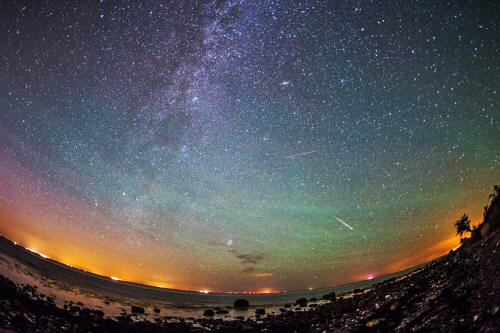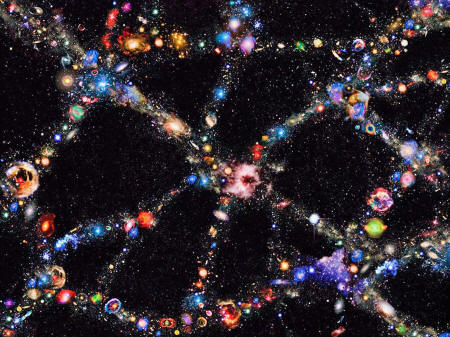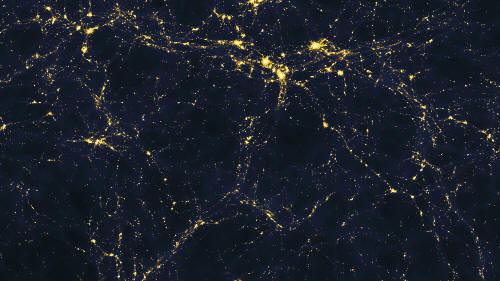This animated flight through the universe
shows close to 400,000 galaxies.
Anyway, scientists working for the Baryon Oscillation Spectroscopic Survey - the international galaxy-mapping effort from which the BOSS gets its truly spectacular acronym - say that the newly discovered cosmic feature is the largest structure in the universe.
Or at least, as much of the universe as they've mapped so far...
In a study (Discovery of a Massive Supercluster System at ȥ~0.47) published in the newest issue of the journal Astronomy and Astrophysics, the scientists describe the BOSS Great Wall (BGW) as an enormous collection of galaxies more than one billion light-years across.
"It was so much bigger than anything else in this volume," Heidi Lietzen of the Canary Islands Institute of Astrophysics, a lead author on the study, told the New Scientist.
"Walls" like the BGW are part of the underlying structure of the universe.
Most of space is a vast empty void, and all the stuff that astronomers look for - stars, planets, the galaxies they constitute - is threaded through that nothingness. Pulled together by gravity, galaxies coalesce into clusters, which in turn form larger structures called superclusters, as explained by PBS.
Those are then corralled into "walls" - the coronary arteries of this giant system of matter, and the biggest things in space.
Researchers for the Sloan Digital Sky Survey (the BOSS survey is one of its projects) have been trying to map that web in order to better understand the universe's history, size and speed of expansion.
Using a dedicated telescope located in the remote desert scrubland of Sunspot, N.M., they scan huge swaths of the sky for distant galaxies, brilliant quasars and other celestial objects.
In the process, they've found some pretty enormous things. Like the "Sloan Great Wall," which Heidi Lietzen and her co-authors say is the closest system of superclusters comparable to the BGW.
But even that is dwarfed by the Sloan survey's newest find.
An illustration of galaxy superclusters and cosmic voids,
similar to the structure of the BOSS Great Wall
(Science Photo Library/Corbis)
The BOSS Great Wall has ten times the volume of the Sloan Wall and is almost 70 percent larger in diameter. It comprises four superclusters containing 830 galaxies, and it looms in space some 5 billion light-years away from Earth.
(For what it's worth, the biggest thing in our neck of the woods, the Laniakea supercluster that includes our own Milky Way galaxy, is less than half the size of the BGW.)
Indeed, the BGW is so big that some scientists question whether it can really be considered all one thing.
"I don't entirely understand why they are connecting all of these features together to call them a single structure," Allison Coil, an astrophysicist at the University of California at San Diego, told the New Scientist.
"There are clearly kinks and bends in this structure that don't exist, for example, in the Sloan Great Wall."
But size isn't really the point, Smithsonian Magazine noted.
The discovery of the BOSS Great Wall is just one part of a larger survey that will - astronomers hope - reveal not just what the universe looks like, but how it's evolved and how it continues to change.
Which is a very nice sentiment. But the BOSS Great Wall is still biggest. And you know what that makes it?
A winner...
...is So Big it Could Rewrite Cosmological Theory
by Conor Gearin
11 March
2016
from PBS Website
Astronomers just observed the biggest collection of
star stuff that we've seen so far.
An international team of scientists described a huge
wall of galaxies in a little-explored part of the
cosmos. It's over a billion light years long,
bristling with 830 galaxies. They have dubbed it the
BOSS Great Wall, named after the BOSS survey which
spotted it.
At the largest scale, matter in the universe forms
long threads and dense clusters - like a net with
big knots. Between the threads are voids drained of
almost all matter.
In 2014, astronomers
learned that our Milky Way galaxy is just one of
many in the
Laniakea supercluster,
which is a web of 100,000 galaxies.
The universe is a web of
giant clusters of matter surrounding empty voids.
Above
a computer-simulated image.
But superclusters can stick together and form even
bigger structures.
The BOSS Great Wall is a tight network of four superclusters. The largest two form a stretched-out wall of galaxies that's about 1.2 billion light years long. This is one of only a few supercluster systems ever found.
Only one other system, the Sloan Great Wall, comes close in size, but not quite close enough - BOSS has over twice as many galaxies and is 170% wider than Sloan.
"It looks like we have a structure that is bigger than anything else: like two Sloan Great Wall scale structures right next to each other," said Heidi Lietzen of the Institute of Astrophysics at the University of La Laguna in Spain, who was the lead author of the new study.
"The question now is: is it too big for our cosmological theories?"
Scientists are still figuring out what shapes supercluster systems like this one can take, said Elmo Tempel, an astronomer at the Tartu Observatory in Estonia and a co-author on the study.
Since they've only found
a few systems of this scale, astrophysicists aren't
sure whether they always form wall-like structures
or if the one's they've seen are special cases. The
next step is to run simulations of the shapes that
superstructures this massive tend to form, Tempel
said.
Superclusters have their origins in pools of
dark matter that
formed early in the universe's history, said
Brent Tully of the Institute for Astronomy at
the University of Hawaii.
Normal matter flows
towards the wells of dark matter, giving the
universe its web-like structure.
While Tully agreed that the BOSS Great Wall
is indeed the biggest structure in the universe
we've found so far, he doesn't think it will change
our theories of how the cosmos gets its shape.
(There is another contender for largest structure in the universe, but instead of being made of something, it's made of nothing.)
"It is not surprising that if we look at a bigger patch of the universe we find something bigger," Tully said. "But not so much bigger that it disrupts the generally held view of structure formation."
What's more, Tully said that the BOSS Great Wall won't be the last word on giant superstructures - there's plenty of universe left to explore.
"Look in a new place and you'll find something new," Tully said.
Astronomers already know where to look next.
Heidi Lietzen explained that the survey data the team used to figure out the large-scale structure of objects only covered a quarter of the night sky.
"There could very well be another equally big system of superclusters somewhere in the Southern sky, for example," Lietzen said.




